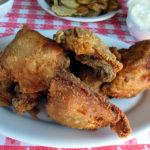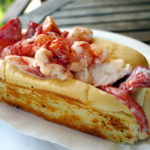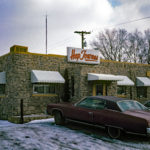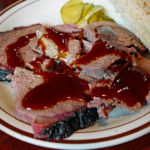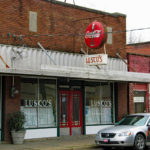Al’s Breakfast
Al's Breakfast, of Minneapolis, Minnesota, serves the best morning meal in town. Handsome half-moon omelets, creamy scrambled eggs, broad flapjacks made from buttermilk or whole-wheat batter, and crusty hashed brown potatoes have helped make this diner a breakfast benchmark in the Midwest for half a century. Hearty meals are only part of Al's charisma; regular customers love the place for its character and history. There is a sign out front that identifies the diner as the "Dinkytown Branch," but the sign is a joke. Al's is indeed located in Dinkytown—a neighborhood named long ago for its railroad yard, where train conductors parked their dinkeys (small locomotives and hand-powered carts)—but this particular branch is the only one. Al's is an establishment so odd that it could not possibly be duplicated.
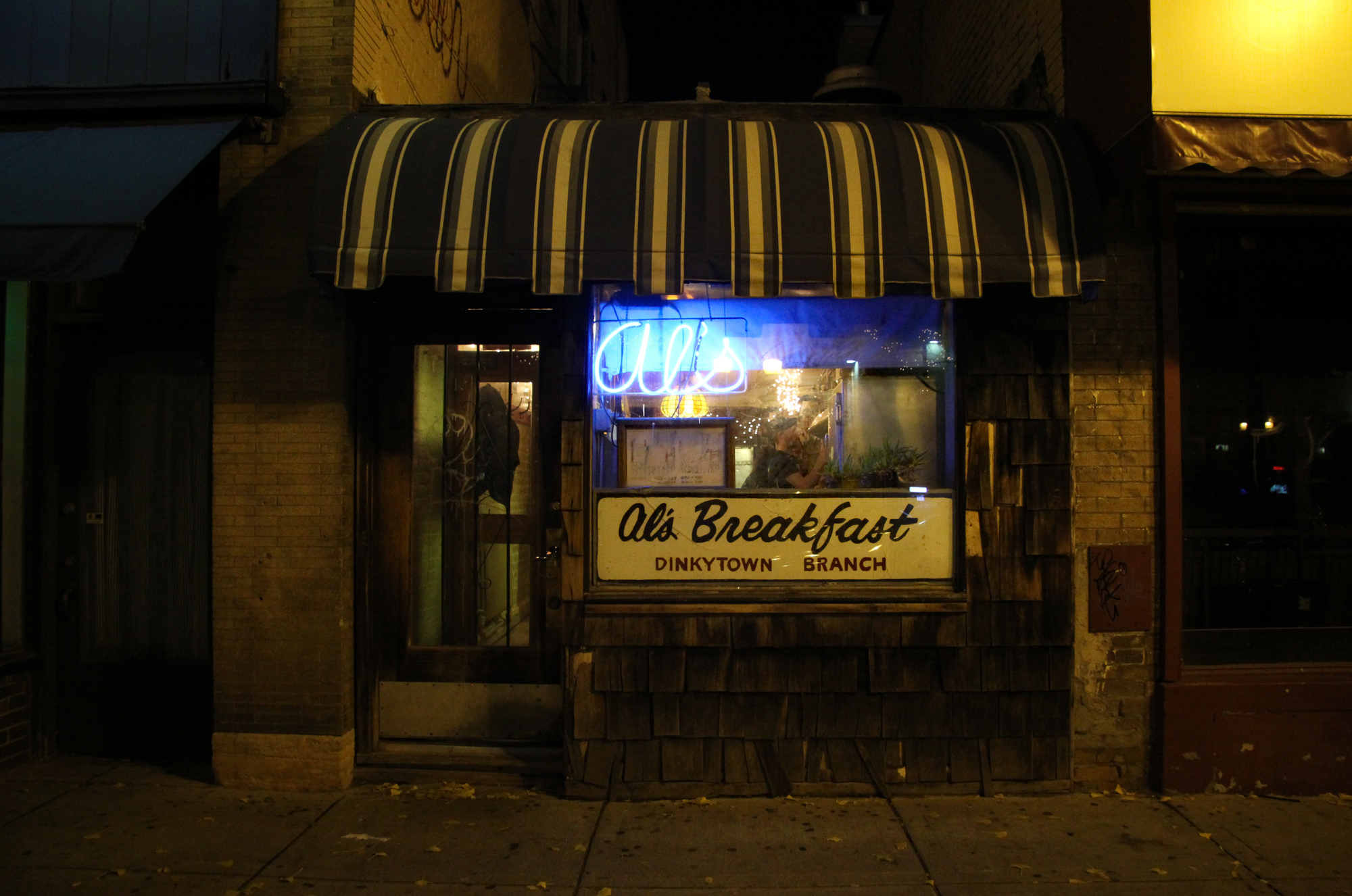
By Jane and Michael Stern
Originally Published 1994 Gourmet Magazine
Al’s Breakfast, of Minneapolis, Minnesota, serves the best morning meal in town. Handsome half-moon omelets, creamy scrambled eggs, broad flapjacks made from buttermilk or whole-wheat batter, and crusty hashed brown potatoes have helped make this diner a breakfast benchmark in the Midwest for half a century. Hearty meals are only part of Al’s charisma; regular customers love the place for its character and history.
There is a sign out front that identifies the diner as the “Dinkytown Branch,” but the sign is a joke. Al’s is indeed located in Dinkytown—a neighborhood named long ago for its railroad yard, where train conductors parked their dinkeys (small locomotives and hand-powered carts)—but this particular branch is the only one. Al’s is an establishment so odd that it could not possibly be duplicated.
If you’re looking for a quiet mealtime, gracious table settings, and suave service, find another place to eat. When you walk into Al’s, you are asking for breakfast with an alarm-clock jolt. Coffee is strong and served in a bottomless cup. Service is sassy, often hilarious, occasionally rude. The place itself, which is always noisy and crowded, is totally ridiculous.
Small isn’t a little enough word to describe it. Only ten by eight—actually 79 square feet altogether—Al’s is built around an ancient counter of worn yellow linoleum with twelve stools permanently attached in a narrow aisle down which any good-sized person has to walk sideways. At each end of the counter there is one portable stool, raising the total seating capacity to fourteen. In the front window of the restaurant, behind the counter, there is a grill where a cook pours and flips pancakes, sizzles corned beef hash and hash browns, makes toast, and tends a waffle iron. He also has a stove with two pots of boiling water in which he poaches eggs. A couple of waitresses patrol the counter, armed with coffee pots for refills.
In the back lies a minuscule kitchen through a short doorway with an old sign overhead that reads THERE IS NO FULFILLMENT HERE. No one who now works at Al’s can recall why the sign is there or what it refers to. In the back kitchen eggs are fried, omelets are cooked, and prep work is done: pancake batter mixed, potatoes grated, ingredients chopped. Altogether five people can be behind the counter at any one time, but it seems like many more. The cook in back breezes up front to deliver trays of raw eggs to the grill man; the grill man floats back to pick up vinegar for his poaching water; an Al’s acolyte saunters in through the back kitchen and loiters near the wooden coffee-filter cabinet that is decorated with a portrait of Elvis from Jailhouse Rock; everybody, on their way, stops to gab with breakfasters or with each other.
In a joint this size, conversations are communal unless they are whispered. (Ice fishing was the topic one morning late last spring. Someone mentioned that the village of ice huts that fishermen build every year on Lake Minnetonka had just about melted by now….”Did you know that local businessmen put up kiosks made of ice to sell fishermen meals and bait?”…”I hear those guys who live out on the lake all winter get mail delivered to their ice houses.”) Customers who would rather not talk can pick a newspaper from stacks of well-thumbed dailies and weeklies that are stored just below the counter. Or they can stare straight ahead at a collection of paper money from around the world taped helter-skelter to the wall, some of the bills garlanding a sign from the old days that says TIPPING IS NOT A CITY IN RUSSIA. Above the money resides a small collection of dusty hard hats and a Shriner’s fez.
On low shelves opposite the counter is an array of about 250 meal ticket books arranged in rough alphabetical order according to their owners’ names, which are written with big black marker on the outside. The meal ticket policy is a legacy from the 1940s, when most customers were workers in nearby munitions factories. To be certain they could eat even if they blew their wages at the corner tavern, each payday they bought a $5 book of tickets, good for a week’s supply of meals. Today students at The U (University of Minnesota) who make Dinkytown their stamping ground can buy a book for $20. Underneath the counter there are shoe boxes filled with inactive books, some going back twenty years or more. When Al’s alumni return to Dinkytown, their meal tickets are still good.
There is always plenty of noise behind the counter.
“Two with Cheddar and sausage, butter, and a short stack,” a waitress calls toward the front. A short stack is two pancakes. A short-short is one. A long stack is four.
“Scramble two on an oval!” the grill man hollers into the back kitchen, referring to an oval plate, which means that he needs room for a heap of hash browns.
“Two with smoky on a round,” a waitress yells into the back. Smoky means smoked Cheddar cheese, which is scrambled with the eggs and—unless you say differently—plenty of cream and butter. The round plate has no room for potatoes.
“Benny, double holly!” is the call for eggs Benedict with extra hollandaise. “Here’s an hors d’oeuvre while you wait,” says Doug Grina, the day’s chef, as he walks along behind the counter carrying a dime-size pancake on his spatula—a mere drip from the griddle. He flips the miniature pancake onto a plate and pushes it across the counter toward a seated customer. “What are you trying to do, get healthy?” Doug razzes a college student who has ordered her short stack dry, i.e., without a blob of butter melting on top. “Here it comes,” waitress Rose Jensen announces as she totes a tub of butter up front for Doug to use. “Here’s the favorite dish we serve at Al’s.” (Butter is a regional obsession not unique to Al’s. It is at least as big in Minnesota as in Wisconsin: At the annual state fair it is used to sculpt likenesses of the Fair Queens.)
Al’s seems like chaos, but somehow it works. Nearly everybody gets what they order, even if they want their eggs poached rock-hard or over ultra-easy or their hash blackened. It is not fast food—not like a franchise, anyway. Breakfast can take as long as twelve or fifteen minutes to prepare. Hash browns alone spend seven or eight minutes on the grill, more if you like them with a brittle surface. Because egg-poaching facilities are limited and poached eggs so popular, there is sometimes a backlog of orders. Nobody gripes about the wait because few people come to Al’s for a hurried, anonymous meal. Customers cherish time spent here. Each person at the counter becomes part of a ritual morning comedy that is at once unpredictable and reassuringly familiar.
Being cozy is part of the Al’s experience. It can get mighty crowded in the little diner, especially in winter when it’s too cold to stand outside. People hover in the aisle behind the stools, sharing space with coats hung on wall hooks and trying not to breathe down stool-sitters’ necks. No one seems to mind the inconvenience of the periodic calls from the cook and waitresses for singles or groups to please “move right one” or “move left two” so that a couple or small group can sit together. When the call is given, everybody slides their coffee cup, plate, and silverware in the requested direction, and everybody’s happy. A souvenir T-shirt printed up a few years ago shows the revered fourteen stools and says SO MANY FRIENDS, SO FEW SEATS.
The menu is basic: omelets, scrambled eggs, pancakes, waffles, and hash. The pancakes are extraordinary, especially those made with buttermilk batter. They are plate-size, thin, faintly chewy, with a good sour smack provided by the buttermilk. Rivulets of butter and sweet syrup result in perfection, but variations include the addition of blueberries or giant blackberries to the batter, whole-wheat cakes instead of buttermilk, and corn kernels or walnuts sprinkled on top as the pancakes cook. For garnishing these distinguished flapjacks—along with the aforementioned butter and regular syrup—there is extra-cost pure maple syrup, sour cream, or bowls of berries.
The fragile, free-form poached eggs at Al’s have an uncommon savor, too. Cooked in vinegar water, then briefly bathed in pure hot water, they retain a hint of acid zest. Many customers get them in the classic eggs Benedict configuration—on Canadian bacon and English muffin halves, gilded with freshly made hollandaise. The hollandaise is also served over scrambled eggs and plates of potatoes. We saw one patron order a bowlful and use it as a dip for rye toast.
The tantalizing aromas that billow from the grill up front come primarily from two of Al’s specialties: corned beef hash and hashed brown potatoes. The hash has a briny, well-spiced aroma and is thickly laced, with shreds of potato. How it’s served is up to you—limp and tender and glistening soft or fried to a mahogany crisp. Al’s hash browns will warm the heart of anyone who recalls the great potatoes once served by the Toddle House chain of night-owl eateries: hash-house hash browns extraordinaire! They start as cooked and cooled medium-sized red-skinned potatoes that are grated on the same kind of trapezoidal kitchen grater we all use at home. They are then piled on the hot grill like a haystack. The cook uses his spatula to pat them into a dense circle about six inches in diameter and half an inch thick. He reaches for a pitcher of vegetable oil and pours some on the circle. After about six minutes, the potato shreds have become a single crisp-bottomed disk. The disk is flipped and cooked some more. Even when the browns are cooked well-done, the interior is moist, soft, and spuddy. The outside turns into crunchy potato lace.
All these dishes are prepared today as they were cooked at Al’s ten, twenty, thirty, and forty years ago. There have been only a few minor changes. Griddle man and co-owner Stephen Hollick came up with the idea of making blackberries an option in the pancake batter. The oil that is used to flavor the potatoes, Doug Grina confessed, used to be lard, but this was eliminated for health’s sake. For several months last year Al’s actually opened up for supper, serving Philadelphia cheese steaks from five to ten in the evening, but the experiment was a bust. Says Stephen, “Doug’s from Philly and made beautiful cheese steaks, but not enough people ate them. So it was back to breakfast only.”
To learn more about Al’s, we requested an audience with Philip Bergstrom, nephew of counter-culture patron saint Al Bergstrom. Al himself is now well into his eighties and retired, and Philip is the acknowledged expert on the history of the diner. He came to meet us in the back kitchen mid-morning, dressed in jeans, work shirt, and porkpie hat and sporting a stylish two-day beard growth. If he had been wearing sunglasses, he could have been a third Blues Brother. “I’ll tell you the whole story of this place,” he said, swirling coffee in his cup with cunning glee, “but I’m warning you, it’s a pack of lies.” Actually, he told us the truth, but Philip is the kind of guy who delights in verbal mischief.
In the 1930s, what is now Al’s was an alleyway between two stores. One of the stores roofed over a short length of the alley so it could be used as a machine shop in all weather. In 1938 the covered space was transformed into a diner called Hunky Dory Lunch, and sometime in the early 1940s a fellow named Bill bought Hunky Dory and renamed it Bill’s Place. Dinkytown was thick with tenement housing for war-effort workers, and there were nearly two dozen blue-collar lunch rooms in the area to feed them. Bill was the one who started selling books of meal tickets so that patrons wouldn’t drink up their paychecks.
As Philip stands in the kitchen, downing coffee and regaling us with tales of his Uncle Al’s days as a bootleg yeast distributor during Prohibition, John Marshall walks in the back door and joins the history lesson. Friends of the establishment frequently come in through the back door to say howdy and to have a quick cup on their way to work or school. John, a Minneapolis artist and set designer, is a longstanding devotee of the diner. He fetches his own cup and makes himself comfortable leaning against the syrup and salsa shelf in the kitchen, adding his own reminiscences to Philip’s chronicle.
In 1950 Al Bergstrom bought Bill’s Place. “He paid a grand total of $600 for the business,” Philip says. John chimes in, “It’s got to be worth at least $1,000 now.”
Al’s started as a three-meal-a-day restaurant, with a bank of ovens stationed in the back kitchen. But around 1960, a doctor told Al to slow down. He took a poll among customers asking which meal they liked best, and it was decided Al would limit himself to breakfast. “The Rose Bowl teams of 1960 and 1961 were steady customers,” Philip says. “They were all fed by Al. The coaches paid Al under the counter so the football players could come in here and eat whenever they wanted to. That was also about the time Bob Dylan came to town from up in Hibbing. He sang at The Ten O’Clock Scholar, the coffee house that used to be right across the street where the Burger King is now. Al says he remembers Dylan eating here all the time, but I’m not sure I believe him. Dylan stayed in Dinkytown only long enough to make enemies of every other musician in the neighborhood.”
Philip started working for his uncle as a dishwasher in 1970; then in 1973 he bought the business. “I tried to buy the building, too,” he recalls, “but I found that I couldn’t because it is not a building. It is an alley with a roof” He walks over to a part of the wall in the back kitchen where some ancient yellow wallboard has eroded, revealing the bricks of the building next door.
“In those heady days, I decided I didn’t like any sole proprietorship,” Philip reminisces. “I felt there was something inherently unfair about it. So as soon as I paid Al off, I took in two partners. I felt that Al’s Breakfast was bigger than Al; it was my job to make sure that it continued, and the best way to do that was to make it a communal legacy. Since then, Al’s has had a changing roster of three different owners. I myself am out of it completely and am looking for a job teaching English overseas.” (The current proprietors are Doug Grina, Stephen Hollick, and Jim Brandes.)
The big problem with being overseas or anywhere other than Minneapolis, Philip laments, is that he cannot stop by the old diner whenever he needs company. “When I was teaching English in Turkey two years ago, the only thing I really missed about America was the opportunity to come in here and be guaranteed to see five or ten friends to have coffee with. When you’re feeling a little blue or lonely, it’s a good thing to be able to walk across town and have coffee with friends at Al’s.”
In 1990, to celebrate the fortieth anniversary of Al’s, Philip was given free breakfast for life by the proprietors (he refers to them as caretakers). He planned a big party that year. “I tried to get hold of every single person who ever worked here and every customer I could. Governor Perpich declared it Al’s Breakfast Day, and the street outside was crowded with seven hundred people, some of whom drove from New York and California. One man, a dishwasher at Al’s in 1951, came with his wife, who was a waitress then. They walked around at the reunion arm in arm, so proud to have found each other at Al’s.”
Kitty Kuluvar, who has been a waitress at Al’s for two and a half years, explained that she joined the crew on the advice of her roommate, who had worked behind the counter for twenty years. “A lot of us have children,” Kitty said. “Al’s lets us be flexible. Our kids can come with us to work if they need to, and get fed if necessary. I like working here because we can be grumpy if that’s the way we feel. You know, the customer is not always right, and if he isn’t, we tell him so. Some people enjoy surly service; it’s like being with your bratty brother. There are those who come in here with incredible idiosyncrasies, but we don’t mind—we treat them just like a member of the family. And that’s the way they treat us. The other day there was someone working the counter—I won’t say who—and she was in a bad mood, I mean bad. She made the whole place gloomy. It was so quiet out there, really strange. One guy eating pancakes finally spoke up and said timidly, ‘I like the tension in here.’ Well, that cut it—everybody cracked up and started laughing, even the grouchy waitress. At Al’s, no one pretends. This is real life.”
Rose Jensen tells of how she found the man of her dreams…at the counter of Al’s, where else? She was in the kitchen when he came in with a buddy. He and his friend traded wisecracks with the help, and as Rose and he listened to each other talk, they fell in love. John Marshall, who has never officially worked at Al’s but who brags that he has earned “free short-stack privileges until the year 2000” in exchange for some shelves he built to hold the coffee cups, listens to Rose’s story, nodding his head in agreement. She has proven a favorite point of his: that magic things happen in this old diner.
“Al’s is a living organism,” John explains. “It is not some soulless concept restaurant that a corporate idea man thought up. Good things happen here; people’s lives change. If you want a car, or an apartment, or a sweetheart, come in and sit down. Have coffee and chat a while. Pretty soon, I promise, you will get what you need. Al’s has a life of its own, above and beyond any of us. I truly believe it is a crossroads of the universe.”
Discuss
What do you think of Al’s Breakfast?
Related Articles
Stroud’s
By Jane and Michael Stern Originally Published 1995 Gourmet Magazine Chicken...
The Lobster Roll Honor Roll
Maine is the only state in America that features a picture of cooked food on its license...
Meat-And-Three
A few years back, country singer Ray Stevens invited a New York friend to join him at one of...
Top 12 favorite Ice Cream Scoops
WITH THE EXCEPTION of the hot dog bun, there has never been an edible invention as...
Top 5 BBQ Restaurants | Western Kentucky
Get yourself to Western Kentucky for great BBQ I see the food shows on TV where...
Best restaurants in Greenwood, MS | Hot Licks Delta Style
Ever since we first ate margarine-sauced pompano at Lusco’s, in Greenwood,...

